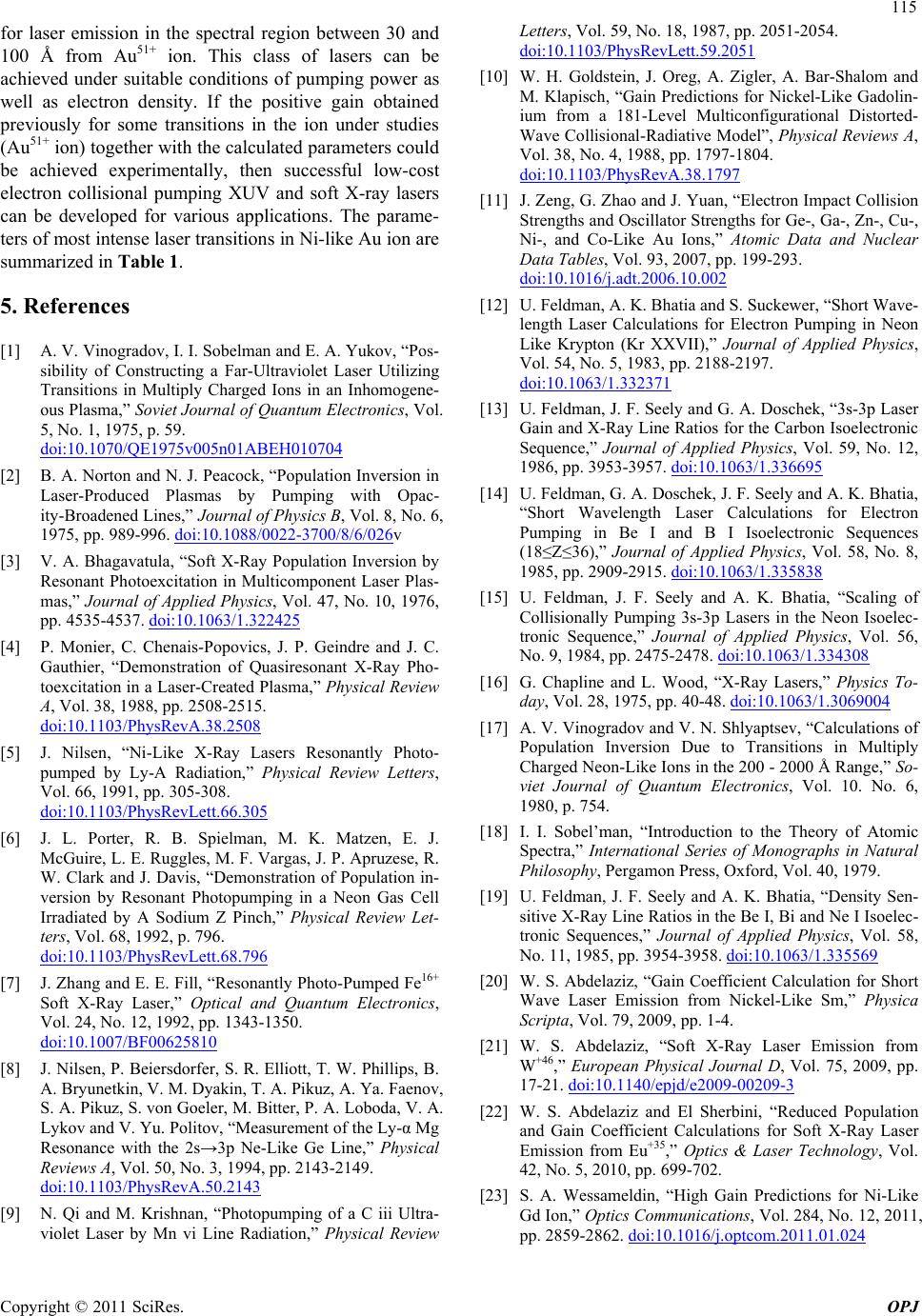
115
for laser emission in the spectral region between 30 and
100 Å from Au51+ ion. This class of lasers can be
achieved under suitable conditions of pumping power as
well as electron density. If the positive gain obtained
previously for some transitions in the ion under studies
(Au51+ ion) together with the calculated parameters could
be achieved experimentally, then successful low-cost
electron collisional pumping XUV and soft X-ray lasers
can be developed for various applications. The parame-
ters of most intense laser transitions in Ni-like Au ion are
summarized in Table 1.
5. References
[1] A. V. Vinogradov, I. I. Sobelman and E. A. Yukov, “Pos-
sibility of Constructing a Far-Ultraviolet Laser Utilizing
Transitions in Multiply Charged Ions in an Inhomogene-
ous Plasma,” Soviet Journal of Quantum Electronics, Vol.
5, No. 1, 1975, p. 59.
doi:10.1070/QE1975v005n01ABEH010704
[2] B. A. Norton and N. J. Peacock, “Population Inversion in
Laser-Produced Plasmas by Pumping with Opac-
ity-Broadened Lines,” Journal of Physics B, Vol. 8, No. 6,
1975, pp. 989-996. doi:10.1088/0022-3700/8/6/026v
[3] V. A. Bhagavatula, “Soft X-Ray Population Inversion by
Resonant Photoexcitation in Multicomponent Laser Plas-
mas,” Journal of Applied Physics, Vol. 47, No. 10, 1976,
pp. 4535-4537. doi:10.1063/1.322425
[4] P. Monier, C. Chenais-Popovics, J. P. Geindre and J. C.
Gauthier, “Demonstration of Quasiresonant X-Ray Pho-
toexcitation in a Laser-Created Plasma,” Physical Review
A, Vol. 38, 1988, pp. 2508-2515.
doi:10.1103/PhysRevA.38.2508
[5] J. Nilsen, “Ni-Like X-Ray Lasers Resonantly Photo-
pumped by Ly-Α Radiation,” Physical Review Letters,
Vol. 66, 1991, pp. 305-308.
doi:10.1103/PhysRevLett.66.305
[6] J. L. Porter, R. B. Spielman, M. K. Matzen, E. J.
McGuire, L. E. Ruggles, M. F. Vargas, J. P. Apruzese, R.
W. Clark and J. Davis, “Demonstration of Population in-
version by Resonant Photopumping in a Neon Gas Cell
Irradiated by A Sodium Z Pinch,” Physical Review Let-
ters, Vol. 68, 1992, p. 796.
doi:10.1103/PhysRevLett.68.796
[7] J. Zhang and E. E. Fill, “Resonantly Photo-Pumped Fe16+
Soft X-Ray Laser,” Optical and Quantum Electronics,
Vol. 24, No. 12, 1992, pp. 1343-1350.
doi:10.1007/BF00625810
[8] J. Nilsen, P. Beiersdorfer, S. R. Elliott, T. W. Phillips, B.
A. Bryunetkin, V. M. Dyakin, T. A. Pikuz, A. Ya. Faenov,
S. A. Pikuz, S. von Goeler, M. Bitter, P. A. Loboda, V. A.
Lykov and V. Yu. Politov, “Measurement of the Ly-α Mg
Resonance with the 2s→3p Ne-Like Ge Line,” Physical
Reviews A, Vol. 50, No. 3, 1994, pp. 2143-2149.
doi:10.1103/PhysRevA.50.2143
[9] N. Qi and M. Krishnan, “Photopumping of a C iii Ultra-
violet Laser by Mn vi Line Radiation,” Physical Review
Letters, Vol. 59, No. 18, 1987, pp. 2051-2054.
doi:10.1103/PhysRevLett.59.2051
[10] W. H. Goldstein, J. Oreg, A. Zigler, A. Bar-Shalom and
M. Klapisch, “Gain Predictions for Nickel-Like Gadolin-
ium from a 181-Level Multiconfigurational Distorted-
Wave Collisional-Radiative Model”, Physical Reviews A,
Vol. 38, No. 4, 1988, pp. 1797-1804.
doi:10.1103/PhysRevA.38.1797
[11] J. Zeng, G. Zhao and J. Yuan, “Electron Impact Collision
Strengths and Oscillator Strengths for Ge-, Ga-, Zn-, Cu-,
Ni-, and Co-Like Au Ions,” Atomic Data and Nuclear
Data Tables, Vol. 93, 2007, pp. 199-293.
doi:10.1016/j.adt.2006.10.002
[12] U. Feldman, A. K. Bhatia and S. Suckewer, “Short Wave-
length Laser Calculations for Electron Pumping in Neon
Like Krypton (Kr XXVII),” Journal of Applied Physics,
Vol. 54, No. 5, 1983, pp. 2188-2197.
doi:10.1063/1.332371
[13] U. Feldman, J. F. Seely and G. A. Doschek, “3s-3p Laser
Gain and X-Ray Line Ratios for the Carbon Isoelectronic
Sequence,” Journal of Applied Physics, Vol. 59, No. 12,
1986, pp. 3953-3957. doi:10.1063/1.336695
[14] U. Feldman, G. A. Doschek, J. F. Seely and A. K. Bhatia,
“Short Wavelength Laser Calculations for Electron
Pumping in Be I and B I Isoelectronic Sequences
(18≤Z≤36),” Journal of Applied Physics, Vol. 58, No. 8,
1985, pp. 2909-2915. doi:10.1063/1.335838
[15] U. Feldman, J. F. Seely and A. K. Bhatia, “Scaling of
Collisionally Pumping 3s-3p Lasers in the Neon Isoelec-
tronic Sequence,” Journal of Applied Physics, Vol. 56,
No. 9, 1984, pp. 2475-2478. doi:10.1063/1.334308
[16] G. Chapline and L. Wood, “X-Ray Lasers,” Physics To-
day, Vol. 28, 1975, pp. 40-48. doi:10.1063/1.3069004
[17] A. V. Vinogradov and V. N. Shlyaptsev, “Calculations of
Population Inversion Due to Transitions in Multiply
Charged Neon-Like Ions in the 200 - 2000 Å Range,” So-
viet Journal of Quantum Electronics, Vol. 10. No. 6,
1980, p. 754.
[18] I. I. Sobel’man, “Introduction to the Theory of Atomic
Spectra,” International Series of Monographs in Natural
Philosophy, Pergamon Press, Oxford, Vol. 40, 1979.
[19] U. Feldman, J. F. Seely and A. K. Bhatia, “Density Sen-
sitive X-Ray Line Ratios in the Be I, Bi and Ne I Isoelec-
tronic Sequences,” Journal of Applied Physics, Vol. 58,
No. 11, 1985, pp. 3954-3958. doi:10.1063/1.335569
[20] W. S. Abdelaziz, “Gain Coefficient Calculation for Short
Wave Laser Emission from Nickel-Like Sm,” Physica
Scripta, Vol. 79, 2009, pp. 1-4.
[21] W. S. Abdelaziz, “Soft X-Ray Laser Emission from
W+46,” European Physical Journal D, Vol. 75, 2009, pp.
17-21. doi:10.1140/epjd/e2009-00209-3
[22] W. S. Abdelaziz and El Sherbini, “Reduced Population
and Gain Coefficient Calculations for Soft X-Ray Laser
Emission from Eu+35,” Optics & Laser Technology, Vol.
42, No. 5, 2010, pp. 699-702.
[23] S. A. Wessameldin, “High Gain Predictions for Ni-Like
Gd Ion,” Optics Communications, Vol. 284, No. 12, 2011,
pp. 2859-2862. doi:10.1016/j.optcom.2011.01.024
Copyright © 2011 SciRes. OPJ